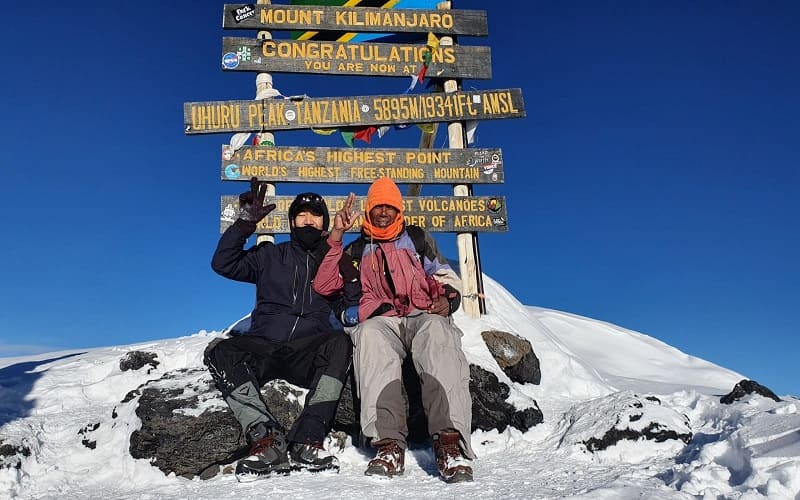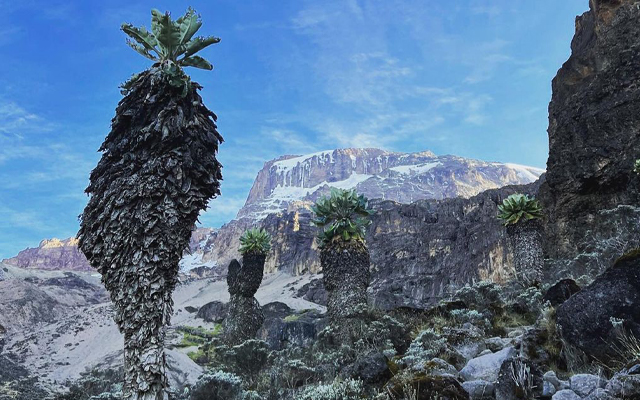
6-Days Kilimanjaro Umbwe Route Itinerary - 2024-2025

The Majestic View of Kilimanjaro from Far
The 6-Days Kilimanjaro Umbwe Route is one of the most challenging yet exhilarating trekking routes on Mount Kilimanjaro. Known for its steep ascent and limited acclimatization time, this route offers a true test for mountaineers looking for a tough climb. The steady incline pushes trekkers to their limits, but the reward at the summit is unparalleled. Those who dare to challenge the Umbwe Route are often granted some of the most spectacular and unforgettable views from the peak of Kilimanjaro.
Climbing the Umbwe Route is a challenge in itself, but proper preparation is key to success. From physical conditioning to mental readiness, make sure you are fully prepared to tackle this route. Mount Kilimanjaro is a majestic and awe-inspiring mountain, and taking on the Umbwe Route will provide a raw and authentic trekking experience that few other routes offer.
For those looking to experience the Umbwe Route and gain first-hand insights into the climb, you can book your trek with expert guides and ensure a safe and successful summit. Knowledgeable guides will lead you through the toughest parts of the climb and provide essential support throughout your journey.
If you're ready to take on the challenge and book your trek, please contact us via email at info@tanzaniaadventures.co.tz. When sending your inquiry, please include the following message to help us track your request:
You will be picked up at the Kilimanjaro International Airport and transferred to your hotel in Moshi town; you will meet your guide who will brief you on your upcoming trek and do an equipment check to make sure you have all the necessary mountain gear. The missing gear can be rented on this day.
Hotel Accommodation in Moshi: Panama Garden Resort Tanzania
At 8am leave Moshi for Umbwe Gate where you will meet our porters, guides, and cooks who will spend the next six days trekking with you to Uhuru Peak, the roof of Africa. After arriving, wait at the gate while we register your climb and the porters and guides make final preparations. Your first day’s destination is Cave Bivouac Camp, approximately 6 hours from the gate. The trail is steep and can be slippery in some places. Hike through the moss-covered trees of Kilimanjaro’s cloud forest. The forest will thin later in the hike and heathers, tall grasses and wildflowers will come into view. Porters and cooks will walk ahead to set up the camp in time for your arrival.
The first section of the trail continues following the ridge. After leaving the forest, continue through open moorlands until reaching Barranco Camp. Barranco is generally regarded as the most scenic campsite on the Umbwe Trail as it’s surrounded by giant senecios and lobelias. As Barranco is in a valley, the sun rises later than at the other camps.
Leave Barranco Camp after breakfast for Karanga Valley. The day begins with a 1.5 hour scramble up the Barranco Wall. This is the hardest part of the day and in some places you may have to use your hands to aid your climb. After reaching the top, hike through fairly level terrain before making a short but steep descent into the green Karanga River Valley.
After breakfast, begin the hike to Barafu Camp. On the way to Barafu, view several of Kibo’s glaciers as well as the junction that connects the descent route, Mweka, with the Machame trail. During day four, hike by the Heim, Kersten and Decken Glaciers. Although the trail to Barafu passes through alpine desert with little vegetation, Barafu Camp offers stunning views of Kibo and Mawenzi peaks. Try to sleep after finishing dinner as you will wake before midnight for your summit hike.
Around midnight, begin the final ascent to Uhuru Peak. Hike by the light of your headlamp for the next six hours. The ascent to the crater rim is the most challenging part of the entire trek. The trail is very steep until you reach the crater rim at Stella Point. The hike from Stella Point to Uhuru Peak is a gradual climb and, as far as hikes go, not very difficult. The altitude, however, makes the hike long and tiring. The crater rim hike takes approximately one hour. Upon reaching Uhuru, take photos of your guide and group at the peak before beginning the descent to Mweka Camp. On the way down from Uhuru, enjoy views of the mountain, crater, clouds and glaciers. At Barafu Camp, eat breakfast and take a short break. You still have another three to five hours to go before reaching Mweka Camp.
After breakfast, finish the trek with a hike through the forest to Mweka Gate. The trail may be slippery following rain. Our vehicles will meet you at the lower station of Mweka Gate to take you back to Moshi.
Kilimanjaro Is Climbable All Year Round. The Best Months To Climb Are December-March, And September-October, Which Are The Warmest And Driest Months. The Next Best Are June To August, But They Are Colder. July, August, And September Are The Busiest Months. Summiting On Or Soon After A Full Moon Is Very Beautiful And Helps Illuminate The Landscape Without Using Headlamps. However, It Is Also Very Bright For Sleeping And Stars Are Not As Visible.
Malaria Is A Serious Problem In East Africa So You Must Consult Your Doctor About Getting Effective Malaria Prophylaxis For Your Visit. Many People Are Avoiding Lariam Nowadays And Using Malarone. You Cannot Catch Malaria Above 3000 Metres On Kilimanjaro, But You Must Be Careful Below That Altitude, Particularly If You Visit The Coast Where The Strains Of Malaria Tend To Be Especially Virulent.
Temperatures Range From 25 To 30 Degrees Celsius At The Foot Of The Mountain And -15 To -20 Degrees Celsius On Top Plus Wind Chill. Lower Down, It Can Be Wet And Humid, But Higher Up, There Can Be Snow. Rain And Snow May Be Encountered Any Time Of The Year!
Your Decision Will Depend On Where You Want To Sleep And The Hiking Distance Each Day And Number Of Days Of Each Route. On The Marangu Route, You Sleep In Huts With Simple Beds, While On All The Other Routes, You Sleep In Tents. There Are Two Main Routes On The Mountain: The Marangu And Machame. You May Also Want To Consider The Rongai Route As It Is Far Less Traveled. The Lemosho Route Is A Good Choice If You Want A Longer Route (8+ Days). Kindly Visit Our Kili Routes Page.
Physically, The Marangu And Machame Routes Are Rather Different. The Main Force Of Kibo's Volcanic Activity Occurred Out Towards The West (The Machame Side) And So Machame Is Steeper - Especially In The First Day And A Half - And More Rugged Than Marangu. It Is Often Considered More Scenic Because The Views Of Kibo Are More Impressive Than From The South-East (The Marangu Approach), But Many Consider The Vegetation On Day 2 Of The Marangu Route To Be More Attractive Than Anything Seen On The Western Side. As Always With Mountains, Every Route Has Its Advantages And Drawbacks. The Difficulty Grading Has Marangu As A 1, And Machame A 1+, So There's Not A Great Deal In It.
Always Remember To Maintain A Slow, Steady Pace From Beginning To End. Going Slowly Allows The Body To Acclimatize While Hiking. Those Who Start Out Too Quickly Will Have Troubles Higher Up The Mountain As The Body Will Be Overexerted. This Still Holds True If You Are Spending An Extra Day On The Mountain.
It Will Depend On The Route You Pick And Your Pace. It Can Take From 4-8 Hours To Reach The Summit From The High Camp.
A Weatherproof Jacket, Such As Gore-Tex.
A Woollen Sock That Fits Over The Head With Slits For Only The Eyes And Mouth.
Most Groups Will Start For The Summit On Ascent Day At 11 PM To 12:30AM, Depending On The Perceived Fitness Of The Group, The Weather And The Route. The Pre-Dawn Hours, While Cold, Are Also The Calmest And Clearest. The Best Views From The Summit Are At Dawn. Often Clouds And High Winds Develop Not Long After Sunrise Making The Summit Much Less Attractive And The Descent More Difficult. Guides Who Have Been To The Summit Scores Of Times Report That It Is Very Rare To Find It Cloudy At The Summit At Dawn In Any Season. The Ascent Day Is A Very Long Day Of Hiking. Some People May Require 15 Hours To Reach The Summit And Descend To The Campsite For That Day.
No, But We Can Schedule Transfer From Nairobi By Riverside Shuttles For An Additional Charge.
If A Client Cannot Walk Because They Are Injured Or Sick, At Least Two Support Staff Will Assist This Climber Down. There Is No Extra Charge For Coming Down And Taken Back To The Hotel, But You Will Get No Money Back For That Mountain Days You Missed, And You Will Be Responsible For Medical Assistance And Extra Hotel Nights. We Highly Recommend Travel Insurance To Cover Any Medical Expenses And Further Evacuation
The Typical Tip Is: Porters $10 Per Day Per Porter Cooks $12 To $15 Per Cook Assistant Guides $15 To $20 Per Guide Kilimanjaro Guides $20 Per Day And Up Per Guide *Tip Amounts Listed For Kilimanjaro Are Per Group, Not Per Individual Traveler. For Instance, If Four People Are On Kili, They Should Each Contribute $5/Day If They Want To Tip The Lead Guide $20.
A 30% Deposit Is Required At Time Of Booking To Hold Your Climb/Safari.
